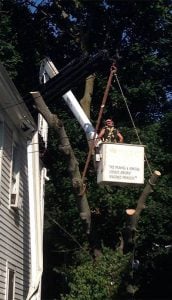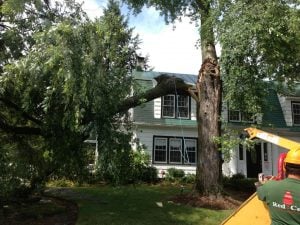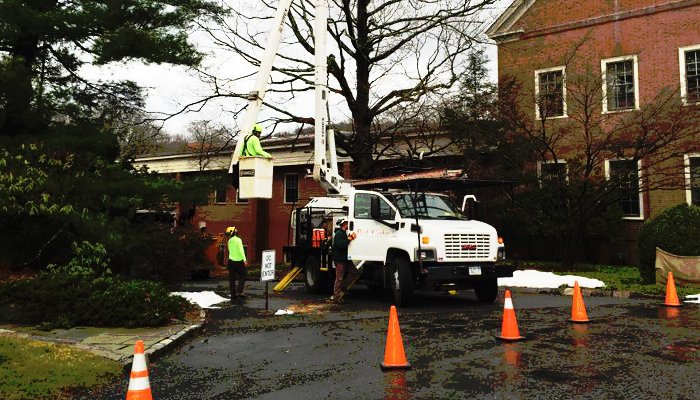If you are in the process of buying a house, you probably understand that it is pretty much standard today to have a home inspection done prior to closing, but have you considered adding a tree inspection to the “before closing to-do list”? Tree inspections are often overlooked during the house hunting process, but they shouldn’t be.
There are several aspects of your future property’s trees to evaluate:
- Proper Placement
- Full Growth Potential
- Species
- Health
- Structural Integrity
- Left Behind Stumps
Placement Issues:
 If your tree is placed too close to your home, this could potentially cause damages as it grows. Damages could refer to branches breaking and landing on your home, oversized roots damaging your driveway or foundation, or shading issues. Having a tree for shade could be a desirable feature, but it could also pose some problems. Shading can lead to mildew buildup on your roof and other areas that are shaded, as well as hinder the growth of your lawn under it due to the lack of sunlight.
If your tree is placed too close to your home, this could potentially cause damages as it grows. Damages could refer to branches breaking and landing on your home, oversized roots damaging your driveway or foundation, or shading issues. Having a tree for shade could be a desirable feature, but it could also pose some problems. Shading can lead to mildew buildup on your roof and other areas that are shaded, as well as hinder the growth of your lawn under it due to the lack of sunlight.
Growth Potential:
It is important that the full growth potential of a tree be considered before planting it in your yard. If a tree is too big for your property or too big for where it was planted, there is great potential for future damages (like the ones listed above) as your tree begins to reach its mature age. If a tree is too big for where it is placed and/or the property in general, it does not mean you should not buy the home, but this tree(s) will likely need removal. So, be sure to calculate that into your home buying expenses.
Species:
During your tree inspection prior to buying a house, your arborist will also look for plants and trees that are not native to its surroundings. When foreign plants or trees are introduced into a non-native region, they can easily become invasive because they outcompete our native plants for resources such as nutrients and light. For this reason, they can be detrimental to your landscaping. While most invasive species are found in wooded areas, some are purposely brought to a backyard without realizing the effects they can have.
Health & Structural Integrity:
 If a tree is diseased or damaged, this could result in devastating damages to what’s below it (like your home’s roof), but it can also mean trouble for the rest of your landscape. Disease can spread underground to nearby trees through their roots, or from tree to tree by animals. If disease is found during inspection, pest and disease management techniques can help to control this disease from spreading. You can also look into removing these trees as an alternative. It is important to understand that structural integrity cannot always be spotted by an untrained eye.
If a tree is diseased or damaged, this could result in devastating damages to what’s below it (like your home’s roof), but it can also mean trouble for the rest of your landscape. Disease can spread underground to nearby trees through their roots, or from tree to tree by animals. If disease is found during inspection, pest and disease management techniques can help to control this disease from spreading. You can also look into removing these trees as an alternative. It is important to understand that structural integrity cannot always be spotted by an untrained eye.
Stump Removal:
A very large stump left behind on a property may be an indication that a previous homeowner removed a tree that may have been suffering from any of the above issues. However, leaving the stump behind means the problems have not entirely been solved. If the stump of a tree remains, so too does its roots. This means that if the tree was diseased, these roots can still spread the infection. It also means that if the tree was removed because it was too big, the extremely large roots underground can still have damaging effects (driveway or foundation damage). Additionally, a stump is an ideal home for pests like termites as they are attracted to dead trees. If this stump is close to your home, there is a high potential that these termites may move onto chomping on your home. Aesthetically speaking, stumps are not pretty. If your dream home has a large stump that was left behind, stump grinding services should also be added to your renovation/to do list.
Buying a house is a huge decision, and because of this, all aspects of the property should be thoroughly inspected and considered prior to closing. It is always a good idea to add a tree inspection by a professional Arborist to your inspection checklist.
Here are some of the things that your professional Arborist, like the staff at Red Cedar, will be looking for:
- Dead, diseased or dying trees
- Major branch damages/hazard limbs
- Pruning needs
- Potential impact on trees of any new construction to be done
- Trees that are too close to the home
- Stumps left behind
- Root disruptions to the structural components of the home
- Pests and/or infestations
Buying a house is stressful and we know the last thing you want to do is add another thing to your to-do list prior to closing, but all aspects of your potential property should be inspected, and that includes your trees. When looking at houses for sale, if you think you’ve found your dream home, call Red Cedar today for your free consultation and make sure your property is move-in ready!


